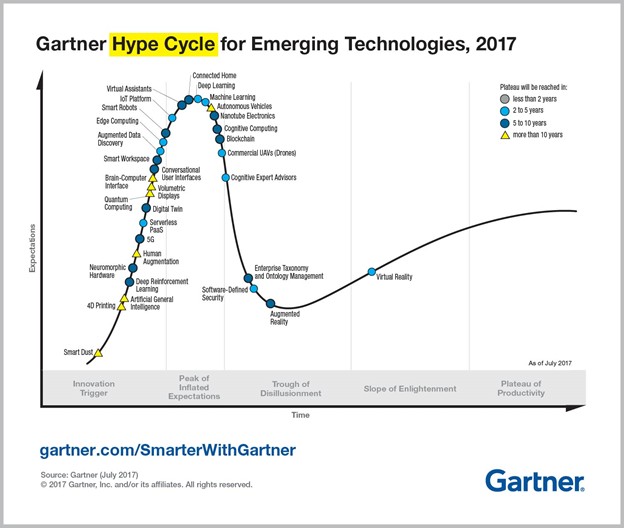In my role as Principal Solutions Marketing Manager for BMC’s TrueSight SaaS analytics and monitoring solutions, I’ve had the opportunity to talk with hundreds of customers this past year about Artificial Intelligence for IT Operations (AIOps). If you haven’t heard about AIOps before, learn more here.
In both 1×1 meetings and at events, I’ve spoken to ITOM and ITSM professionals as well as I&O leaders about what AIOps means to them. In this blog post I’d like to share what I’ve heard (and what I’ve inferred) from IT professionals about what they think about AIOps platforms, vendors, artificial intelligence and machine learning.
There is tremendous excitement about the promise of AIOps
IT leaders are optimistic. They have known for some time that the challenges of digital transformation can’t be met by the traditional IT approach. AIOps shows real promise as a path to success. The idea of a real step-function evolution of IT is energizing and empowering. AIOps also uplevels the conversation from IT silos, bringing practitioners across disciplines together with executive decision makers. It’s a rallying point for the whole IT organization.
But…they feel burned by past unfulfilled promises
IT executives I speak with complain frequently that software vendors have sold them on the promise of a new solution and then not helped them to realize the value of that solution. On their side, they acknowledge that an aversion to professional services, which can accelerate time-to-value, and cultural inertia against adopting new technology, workflows and processes all contributes to failed value realization as well.
This often adds up to significant investment in IT that hasn’t delivered as promised. I&O leaders I speak with are understandably skeptical hearing about new solutions from vendors from whom they purchased solutions that went un- or under-utilized. ITOM professionals who haven’t leveraged all capabilities of a solution are right to question why they need additional software.
And…they are skeptical of the analytics and machine learning ‘hype’
IT pros who have been on the front lines for a long time also express (directly and indirectly) skepticism about the efficacy of analytics and machine learning – all while knowing they need them to address digital transformation. Many have already piloted or tried analytics initiatives in-house or with other vendors prior to our speaking. Results vary from ‘failed’ to ‘mixed’.
This failure to see concrete results from their own, or other’s, analytics and machine learning initiatives drives their skepticism. IT is not a research project – we want to see demonstrable outcomes, and also see that the analytics process is understandable and that it connects to real, measurable problems. Part of this is unclear expectations and perhaps an unwillingness to ‘start the longest journey with a single step’, but vendors must take a strong lead while the market for AIOps is immature and guide customers to a crawl-walk-run approach. Not sexy, but necessary.
They think their data quality is too poor
The first step in building analytics is getting data together. For AIOps, this means immense quantities of varied IT data – like events, tickets, metrics, logs, etc. At this point in its evolution, solutions in the AIOps market are pretty good at doing this. See my other blog post on AIOps and big data for more information.
Of the organizations I’ve spoken with who have succeeded in this first step, they have almost universally discovered (or more properly, ‘validated’) that their data quality is poor. Data can be missing, incomplete, unhelpful, garbled, full of noise, inconsistent, etc. During a Proof of Concept with one customer, we found that 70% of their service tickets had no categorization. Another had free text ‘description’, ‘notes’ and ‘resolution’ fields for each event that contained all the relevant details.
What we generally find is: ‘structured’ data is poor and critical information is in ‘unstructured’ data. In many cases, data quality issues exposed in data aggregation have meant that analytics simply fail or return results that are not trusted.
They are constrained by traditional approaches to IT
This is not a criticism, it’s simply an observation. Think of it as Henry Ford’s ‘faster horse’ syndrome. It manifests in one of two ways: they want to do exactly what they are doing but do it faster and less expensively or they have vague, unrealistic expectations of what AI, ML and big data are going to do for them.
Implementing AIOps successfully requires an understanding of where you are and where you intend to go. Too many AIOps initiatives revolve around existing problems and do not think strategically about reshaping their approach, processes and organizations to account for the new realities of digital business.
So what does AIOps mean to IT leaders?
We are most certainly in the “peak of inflated expectations” for artificial intelligence, machine learning and advanced analytics for IT Operations. (see fig 1) As vendors and partners, we need to acknowledge where our customers are culturally, as well as the reality of the market, and give them a path to AIOps adoption that addresses their expectations and our shared past – even if we see greater opportunities within reach.
[Fig 1]
(source: https://www.gartner.com/smarterwithgartner/top-trends-in-the-gartner-hype-cycle-for-emerging-technologies-2017/)
The outcomes IT professionals expect from AIOps can be categorized generally as automation and prediction. They see the world in terms of what they are currently doing and experiencing. First and foremost, they need to be doing it faster with fewer resources. Their first expectation from AIOps is that it will allow them to automate what they are currently doing manually and thus increase the speed at which those tasks are performed, and therefore also increase the number of those tasks that can be performed in a given time or with a given set of resources.
Some specific examples I’ve heard include: correlate customer profile information with financial processing applications and infrastructure data to identify transaction duration outliers and highlight performance impacting factors; evaluate unstructured data in service tickets to identify problem automation candidates; categorize workloads for optimal infrastructure placement; and correlate incidents with changes, work logs and app dev activities to measure production impact of infrastructure and application changes.
What all these tasks have in common is that they require reason and domain knowledge – determining root cause, identifying outliers, identifying causal relationships, surfacing hidden problems, etc. Customers want AIOps to take over manual investigation tasks and at the same time, they typically aren’t able to share all of the domain knowledge necessary to ‘coach’ an AIOps solution to do what they expect. Practically, this means:
- The desire is for ‘unsupervised’ analysis of their massive digital data sprawl.
- Faith is lacking that AIOps tools can generate meaningful outcomes without their specific domain knowledge.
- Ability to share that domain knowledge is wildly inconsistent.
- Tools rarely address this through usability.
“Prediction” is still very much tied up in troubleshooting culture. When IT managers say they are looking for a system to “predict”, what they are saying is that they want to know in advance when something is going to happen, so they can avoid it rather than having to respond after the fact. At least, this is how it is usually articulated.
What I think they really have in mind about prediction is something more like this: learn what’s normal, learn what abnormal looks like, and when normal is starting to look abnormal, let me know. Pattern matching and trend analysis, broadly construed, extended beyond individual metrics and events defined by system, application or service. Don’t make me define KPIs; make sure that structured data is clean; decide what data to look at or not; decide what analytics to run, etc. Just dump it in a bucket, look for patterns, map it against domain knowledge and let me know what I should focus on.
Customers are overwhelmed with data, they see that traditional management techniques are not up to the task, and they don’t know where to start. They expect AIOps systems to figure it all out. At the same time, the concerns about the validity of the technology and fears of the unknown are still in play. It will not be enough for AIOps vendors, even if they create a solution like this, to simply start predicting without explanation. Customers will need to understand the ‘why’, if not the ‘how’, in order to buy into the outcomes.
Concluding thoughts
I know we say this about every 3 years, but there’s never been a more exciting time to be an IT solution provider. The pace of technological and global change is accelerating, and seismic shifts seem to happen regularly. Established institutions disappear almost overnight and disrupters are themselves disrupted in ever shortening cycles.
The thing that doesn’t change is people. Ultimately everything is measured against the human yardstick. Human factors continue to be the defining criteria for IT solutions – even where the solutions are meant to let machines automate human tasks. Until data science and statistics are taught to everyone from primary school on, AIOps providers can’t expect customers to be able to implement complex data and analytics solutions on their own. And even if those skills were ubiquitous, it wouldn’t mean that their application could always be connected to real-world business problems.
AIOps solution providers need to acknowledge the very real challenges customers face with tools, knowledge and culture; map that against maturity and expectations; and build solutions that engage with customers in the right way for where they are while providing a path to their desired end state.
These postings are my own and do not necessarily represent BMC's position, strategies, or opinion.
See an error or have a suggestion? Please let us know by emailing blogs@bmc.com.






